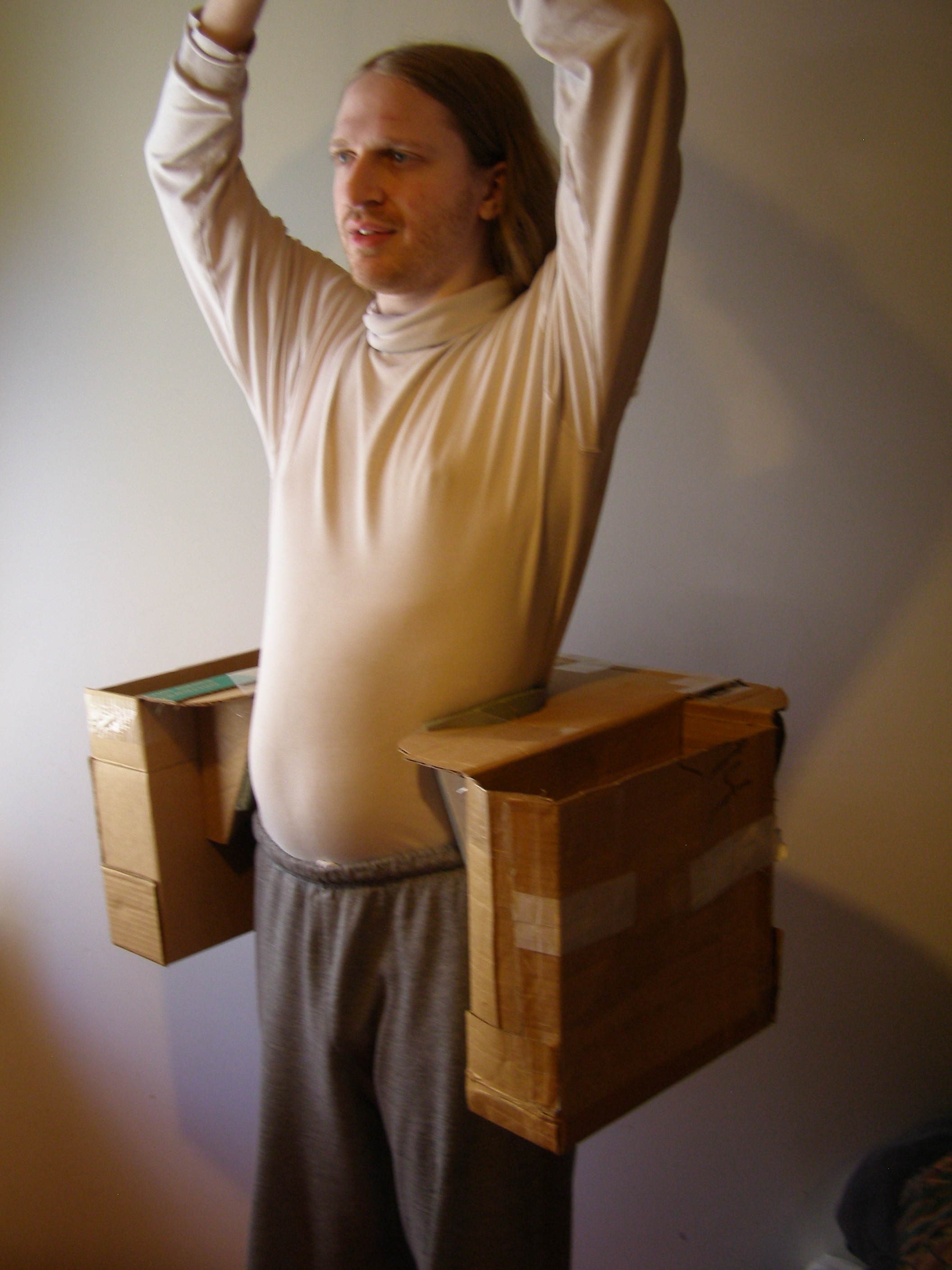Saddlebags 2.0
My original saddlebags were built using a piece of aluminum. But why use regular old aluminum when you can use modern-day supermaterials?
![[Photo: a pile of corrugated cardboard in various shapes.]](/_resources/media/cardboard-pile.S-VMQV9kWIGN_SX.jpg)
That's right, corrugated cardboard is a supermaterial. It's easy to build with, lightweight and strong. People have built chairs and even bicycles out of it. And on top of that, it's absurdly cheap and biodegradable. It's so cheap that I don't even have to buy it directly – I can just reuse the cardboard they use as packing materials when I buy other things.
Behold:
![[Photo: Me, wearing Saddlebags 2.0 around my hips. They are a rectangular-ish cardboard contraption that supports two cardboard boxes at my sides.]](/_resources/media/saddlebags-2-0-demo-1.xhCthDc5OpPercF.jpg)

I call these Saddlebags 2.0. They're a lot bulkier than saddlebags 1.0, but they are heavy-duty. I was able to walk around while carrying 32 pounds (15.5 kg) of encyclopedias in them (16 pounds on each side).
These are 28 inches across. The old ones were 22 inches. (3 of the extra inches are because I used 4-inch pouches instead of 2.5-inch pouches. The other 3 are because the pouches are spaced further apart.) This makes it a little bulky, and I sometimes have to turn sideways to go through doors.
In 1.0, the pouches were allowed to swing from side to side. This made it easier to move my legs. 2.0 has a rigid piece of cardboard connecting the two pouches, which constrains my legs a bit, but has its own advantages. I shaped it to match the shape of my hips, so it has a much better grip. I don't have to worry about it slipping even while I run or bicycle. Because of the grip, they're surprisingly convenient even though they are so wide.
Materials and cost
- A lot of corrugated cardboard – about 17.4 ft²/1.6 m² in total. I got it all from reused packing materials, but if I had to buy it, I could easily get it for about $4.50.
- Two 6"x7" foam pads for my hips. I cut these from an old sleeping pad. Proportionally, they were about $1 worth.
- Some white glue.
- A bit of clear packing tape.
![[Photo: Saddlebags 2.0 from the front.]](/_resources/media/saddlebags-2-0-demo-3.DnkJKnW_IoZboLs.jpg)
![[Photo: Saddlebags 2.0 from the side.]](/_resources/media/saddlebags-2-0-demo-5.Ws4LD7hlLF2qbbR.jpg)
![[Photo: Saddlebags 2.0 from the back.]](/_resources/media/saddlebags-2-0-demo-4.sN-AP5OWX-lveVu.jpg)
The biggest inconvenience so far has been something completely different: Where do I put my arms? Normally, I would hang my arms by my sides, right in the space taken up by the saddlebags. And when I was bicycling, my legs were fine, but I had to keep my arms raised so the front corners of the pouches didn't chafe them. I think I'll try to deal with this by putting a form-padded cover over the pouches, so that it's more comfortable for me to rest my arms on them. For instance, like this:
![[Photo: Me, wearing Saddlebags 2.0, with my arms resting on them and my hands clasped in the front.]](/_resources/media/saddlebags-2-0-demo-6.1-rR7pdtnxTP9_D.jpg)

(And in any case, I need to add some sort of cover to protect the saddlebags in case I get caught in the rain.)
Also, I would like to make the next version a bit narrower. Making the pouches narrower would be easy, but moving them closer together will be a bit tricky to design. If I don't let them swing from side to side, they'll constrain my legs more. And if I let them swing from side to side, they'll naturally rest against my legs. (And if they do, they'll keep swinging inwards and bouncing off my legs when I walk or run while wearing it.) 1.0 could get away with this because its aluminum strut held up the pouches from the outside, so they hung straight down and didn't rest against my legs. 2.0 supports the pouches entirely from the inner top, so the large flat piece of cardboard at the back is necessary to keep the bottoms of the pouches away from each other (i.e. away from my legs).
One idea is to put stops at the back so that the pouches can swing outwards, but not inwards. It would have more moving parts, though, potentially making it weaker.
Overall, 2.0 is Heavy-Duty Saddlebags, sacrificing flexibility to be extra sturdy. If/when I build another version, I think I'll go for more of a compromise.
– Eli
Approximate readability: 4.30 (2736 characters, 674 words, 51 sentences, 4.06 characters per word, 13.22 words per sentence)

 Are my blog posts helpful to you? Consider pledging a few $$$ on Patreon so I can keep putting cool things online for free.
Are my blog posts helpful to you? Consider pledging a few $$$ on Patreon so I can keep putting cool things online for free.
Comments
For parts that rely on compressive strength, I try to align the flutes in the same direction as the compressive force. If I put them perpendicular to the force, it's much easier for the cardboard to fold over along one flute. For tensile strength, the direction doesn't matter as much.
Most of the parts of the saddlebags are mostly using tensile strength. This includes the pouches, which happen to have the flutes oriented in different directions (one goes vertically along the large faces, the other goes horizontally) because I just happened to use pieces of cardboard that were the right shape to make the boxes that way.
The main compressive-strength parts are the hip supports and the big triangular tube at the back. The hip supports aren't very visible and are stuck being diagonal anyway. The triangular tube is the more interesting one. It has the flutes running side-to-side rather than front-to-back, because (I think) the main forces on it are trying to crush parts of it it in the side-to-side direction.
Specifically: In order to resist the downward force of gravity on the material in the pouches, the hip supports have to exert upward force. But the hip supports are at an angle, so every unit of upward force also gives some amount of outward force. The outward force from the hip supports tries to push the two pouches away from each other. But the pouches can't be pushed away from each other unless the triangular tube is bent. Trying to bend the tube puts side-to-side tension on the front part of the tube (and/or the top face), and side-to-side compressive force on the back part of the tube. Since that's the force I'm trying to resist, the flutes are aligned side-to-side. If they were front-to-back, it would be easier for the tube to start collapsing at the back edge.